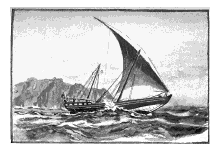OFF CALAIS IN A
DECEMBER GALE
The rig has the advantage
of being easily reduced to snug proportions, while it
offers a fine spread of canvas in light winds, an
especially useful feature in trawling.
For the drift-net fishery,
a number of boats hailing from Calais, and the smaller
ports along the coast westwards round Grisnez, utilise
the English form of two masted lug rig, with main and
mizen lugsails and jib, similar to the modern drift-boats
just across the Channel at Brighton or
Hastings.
HAVRE - TRAWLER SMALL SAIL
The French boats are,
however, as a rule easily distinguishable from the
English by reason of the square cut of the head of their
lugsails and the equilateral form of the jib.
TRAWLER
The English and Scotch
fishermen, during the last half of the nineteenth
century, found that the sharper the peak the better the
set of the lugsail on a wind, and there is no comparison
between either the cut or the set of the average lugsail,
north and south of the Channel.
In the same way, the
English jib is longer in the luff and shorter in the
foot, and is at all events to the accustomed eye a
prettier-looking sail than the equal-sided triangle
presented by the old-fashioned jib of the French, both on
the Atlantic and the Mediterranean seaboards. This shape
appears to be largely a result of the low foremast-head
and the length of bowsprit used with the lateen and the
French-cut lugsails.
The Treport trawler, the
Normandy chasse-maree, and the fishing-fleets as far
round as La Rochelle, show the French peculiarities very
clearly. The foresail often has a bonnet on it for
lightness in bad weather.
NORMANDY CHASSE-MAREE
(FROM A SKETCH BY SIR W. WARINGTON SMYTH)
The unlacing of the
bonnet reduces the sail and avoids the weight and danger
caused by heavy rolls of reefs soaking in a heavy head
sea, which in this rig would often be a serious matter
owing to the forward position of the foremast. The
foremast occasionally, in the larger craft, has a long
pole for a topsail in fine weather, especially for
trawling purposes; and two or more jibs and standing
bowsprit are carried in the bigger chasse marees. The St.
Malo boats are even seen in calm weather with light upper
topsails set over the usual lug topsail.
Some of the beautiful
two-masted luggers which may be seen sailing out of Havre
and other ports, have adopted a higher peak and
proportionately shorter luff with great advantage; and
with their neat sharp sterns, boomed mainsails, and tall
spars, they are not only fast and safe, but also a very
handsome type of boat of which any seaboard might be
proud.
OFF LA ROCHELLE-TRAWLER
This three-masted lug rig,
with local variations (as for instance the omission of
the mizen, the addition of a boom to the mainsail, or
otherwise), may be said to be the national rig of France,
and is retained in all forms and sizes of craft from
men-of-war boats to traders of several hundred
tons.
At Douarnenez and
neighbouring ports fronting 'the Bay' a fine class of
drift-lugger is used, having many of the characteristics
of the Scotch Zulu, such as straight stem and sharp
raking stern-post.
HAVRE TRAWLER
The rig consists of a
dipping lug foresail, set on a very raking mast right
forward, with a main or mizenmast, with great rake aft,
stepped nearly amidships, on which a very sharp-peaked
sail is set.
The gaff sail has made
progress in certain parts, and not a few ketch-rigged
trawlers often purchased in England are now owned across
the Channel; but the national
standing lug, main and fore-sail, appear to be likely to
hold their own for many years to come.
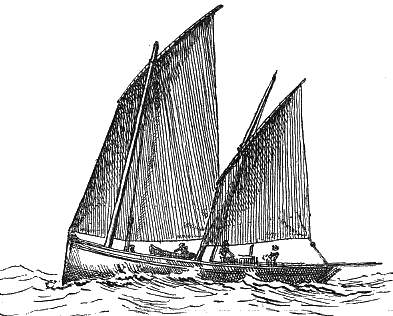
OFF
DOUARNENEZ
In the men who handle these
vessels France has again that reserve store of
industrious, uncorrupted, and fearless men which, in her
case especially, owing to the diseased nature of much of
her civilisation as represented in her fickle capital,
constitutes a treasure of immeasurable value to the
nation.
SAINT-JEAN DE
LUZ
• • •
ST. MALO LUGGER, WITH UPPER
TOPSAILS
If Paris, as has been said,
is a standing peril to France, it is her country-folk,
and above all her seaboard-men who, by their virtues,
have her safety and her greatness in their
keeping.
GUERNSEY PILOT SNUGGED DOWN
Long may France be
able to turn to the intrepid and great-hearted men of
Brittany and Normandy in the day of struggle and
adversity. It is such men that make the true inward stuff
of any nation, and to such that France owes that
marvellous recuperative power which is the admiration of
all, and the astonishment of those who do not know their
France.
CHANNEL ISLANDS BOAT
The Channel Islands fishing
and pilot boats formerly had their three masts all rigged
with the standing lugsail, French fashion. They have now,
however, pretty generally adopted a boomless gaff sail
with considerable peak and good cut, set on the same
mast-plan, in place of the lugsail proper.
Some of these boats are
very fine powerful craft, and much they need to be good
sea-boats in the wild seas and strong tides about the
islands. In light weather the big sail-spread obtained by
the three-masted rig is no less necessary to give them
way across, or against, the strong currents which make
sailing anything but unalloyed pleasure in these
dangerous rock-strewn waters. *1*
*1* Approximate dimensions : 36 ft. by 12 ft. by 8
ft.
The
Mediterranean
Probably no sea in the
world leaves such an indelible mark upon the mind of the
navigator as does the Mediterranean. The long Pacific
roll, the winter grey of the Atlantic, the hot rain of
the Indian Ocean, or the fury of the China Sea, are
written on the worn paint of the hulls that battle them,
and on the hearts of the men who brave them. But the
Mediterranean in its deep summer blue, or in the low
lights of winter, in oily sunlit calm or the haze of the
chill mistral, has a way of its own, a fascination, a
fickleness, and a beauty which are irresistibly
attractive. The sense of colour, the charm of contrast
are nowhere so potent. The constant presence of bold
outlines, of peaceful natural harbours, of all that is
bright and striking in tint and form, and the need for
constant vigilance which the neighbourhood of bold
land-falls in a treacherous sea demands, combine alike to
exercise to the full the powers of observation, and to
impress the mind of the sailor. Other seas of the world
mark deep the heart of man, but the Mediterranean appeals
to all his senses, and writes most upon his
memory.
Behind its physical aspect
lies always the wonder of its historic past. The dim
vista of man's struggle from empire to empire unfolds
itself along these much-navigated shores. Pictures of one
knows not what quaint sea-craft, in which the old
mariners piloted from point to point, arise in the
mind's-eye. Again, the many-banked galleys of Tyre or of
Athens, the high sided corn-ships of Rome and Carthage,
or the gaily coloured merchantmen of Genoa and Venice,
seem to sail out of the mirage in the hull of some humble
tunny boat with the rising sun astern of it.
TUSCAN FISHING-BOAT
(FROM A SKETCH H. W. ROBINS)
And surely of all its
wonders the most wonderful, and a striking tribute to the
little distant Isle of Britain and its people, is the
fact to be writ in future histories, that for over a
century this sea of memories, which has seen peoples and
empires rise, rule, and wane, should have been an
'English lake,' won, patrolled, and kept by the English
fleets.
It is noteworthy that
positively nothing of the ancient Egyptian, or even of
the classical Roman, seamanship or methods of rig or
construction appear to survive in the Mediterranean, or
even in Egypt itself.
GULF OF GENOA
More especially since the
oar-propelled galley has become extinct, it is left to
the Far Eastern seaman alone to revive memories of the
seamanship of the ancients by a conservative retention of
a few very ancient devices known to the older
civilisations. These, doubtless before they were swept
away, the ancient Mediterranean seamen communicated to,
if they did not actually derive many of them from, the
peoples whom they met across the Indian Ocean.
We know that the Egyptians
equipped fleets for the East in the reign of Rameses III,
or about 1200 B.C., and that the Phoenicians
circumnavigated Africa at the beginning of the sixth
century before Christ, under orders from the Pharaoh
Nekan. These voyages probably account for the similarity
of many devices found in our records of ancient Egypt to
those which are still in vogue with the conservative
Eastern seamen.
Our records of the
development of seamanship and shipbuilding in the Middle
Ages are meagre, but the oar, which was so greatly relied
upon by the Greeks and Romans, remained in the
Mediterranean the principal form of propulsion. In that
sea of frequent calms and squally winds such a mechanical
form of propulsion was of the utmost value where speed
was required, and except in the larger merchantmen, the
sail was only an auxiliary even to recent periods when
the mast and sail had long been fully developed by the
nations of North and Western Europe.
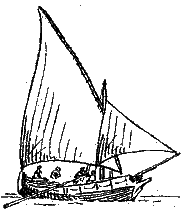 PROIDA
PROIDA
At what period exactly the
squaresail of the Egyptian and classical seamen began to
give way to the lateen, now almost universal for small
craft in the Mediterranean, is not clear, but it seems to
have directly followed the Mohammedan
incursions.
That the lateen was
generally adopted in square-rigged ships during the
fifteenth century, for the mizen sail or driver, on
account probably of its superior
set for holding the wind in staying, we
find from several drawings of that period, and it became
definitely the rig of the Venetian galleys of the
sixteenth and seventeenth centuries, in place of the
classical squaresail which had been retained until that
period, and of which we have records in the galleys as
late as the fourteenth century, disposed as in the time
of Pliny, on fore, main, and mizen masts.
BRAGAGNA
(AFTER E. W. COOKE, R. A.)
The squaresail was still in
use in the Venetian galley of the fourteenth century, but
the galleass class which fought at Lepanto in 1571 had
three masts, all of which were rigged with lateen-sails.
From some old drawings of men-of-war of the sixteenth
century, *1* it would appear likely that the lateen
driver or spanker in North Europe was developed as a
result of the tip forward given to the lower squaresail
yards in cases where the line of the deck from the high
poop to the waist was pitched very steep.
*1* e.g. one of a British man-of-war 1588, given
in Holmes's Ancient and Modern Ships, from
the tapestries of the old House of Lords.
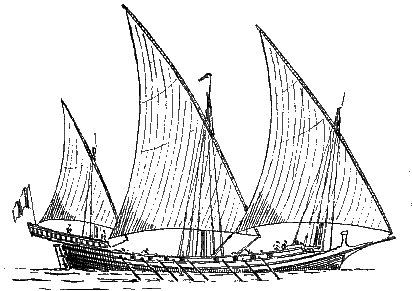
SPANISH AND ARAB GALLEY (SEVENTEENTH
AND EIGHTEENTH CENTURIES)
The sail became practically
a lugsail in this position and when the fashionable angle
of pitch of the deck became much flatter, the advantage
of the better set of the sail in this position was
retained by cutting off the lower fore triangle. The
Henry Grace a Dieu *1* had lateen topsails on her two
aftermasts, and also a lateen topgallant sail.
*1* Launched in 1514.
Whatever the immediate
cause of the use of the lateen in the ships of Northern
Europe in the fifteenth century, which later on developed
into our present fore-and-aft gaff and boom sail, it
seems probable that the Mohammedans already possessed it,
probably in the shape of the present dhow-sail, at a much
earlier date.
COASTER-MESSlNA HARBOUR
Wherever the sailors of
Arabia penetrated either east or west, in the Indian
Ocean or the Mediterranean, the lateen followed them and
remained. Wherever, on the other hand, the Mussulman wave
did not break, or the Arab seaman failed to secure a
footing, as was the case in several parts of the Indian
Ocean, there apparently remained unaltered many of the
oldest devices known to shipmen, and consequently, in
looking for survivals of Egyptian or classical practices,
we have to turn eastward to inland waters of India, to
Burma, to Siam, or even China.
Down to the seventeenth and
eighteenth centuries the old galley under various forms
remained the most characteristic of Mediterranean craft.
The term is the old <-> or <-> which was
applied to the single-decked rowing-vessels which
succeeded the earlier many-banked ships of the Greeks and
Romans, and which were introduced as a result of the
success of the famous Liburnian galleys which won the
battle of Actium.
Even to the early
nineteenth century these vessels were common, and the
name of galley *1* was still applied to single-decked
vessels used for pulling or sailing. *2* They were
used with the felucca rig, and were a favourite class
wherever men enough could be obtained to man the
oars.
As would be expected in a
sea of such sea-memories, the Mediterranean offers at the
present time an unending variety in the craft which sail
its waters. In interest, in beauty, and in
serviceableness they are second to none in the world, and
if ever exhaustively dealt with they would furnish
material for a lifetime's work for a Cooke, a Dixon, or a
Wyllie.
*1* This is almost the only classical boat-name
which
survives, with the exception of <->, a form of
Phoenician
trader from which possibly our Norse term yawl is
derived.
*2* Admiral Smyth's Sailor's
Word-Book.
The Western
Basin
Every visitor to the
Riviera knows the high-stemmed shore boat with the round
sharp stern and the long-yarded lugsail or lateen which,
with minor variations, is used from Alicante to
Alexandria; and many will have noticed the sleek sides of
these boats, which are carvel-built, as sailors say, in
contradistinction to the strong, light clinker-build of
the north.
Along the Spanish and
Riviera coasts these boats have particularly well-built
sterns, with great breadth well aft at the gunwale,
giving them great buoyancy and carrying-power.
PORTUGUESE COASTER
The profile of the hull is
generally peculiarly like that of the blade of certain
figure-skates, the stern stem posts having a tumble-home
at the gunwale and curving gently into the keel which is
itself considerably rockered. The shape is eminently
suited to boats which are continually beached in a heavy
surf.
The sail par excellence of
the Mediterranean is the lateen. As noted above, this
form of lugsail (for such it is generically) is of
Moorish origin, or to be more accurate, it is the adopted
sail of the Mohammedan, for as to its true origin there
is no evidence at present.
LEGHORN COASTER
Its wide spread from the
Aegean to the Atlantic is evidence of the influence which
Mohammedanism has exercised upon modern navigation in
these waters.
The usual rig of the
coasting trader, familiar in all the charming natural
harbours along the Spanish, French, and Western Italian
coasts, is the one-mast lateen with bowsprit and jib. A
light topmast is often carried, upon which is set a
jib-headed topsail, sheeting to the lateen-yard about a
quarter of its length in from the peak. The bowsprit is
also often a long high-pointing spar, upon which one or
more outer jibs may be set beyond the usual big
equilateral staysail or jib now in general use with the
lateen.
The handling of the big
lateen mainsail is a science by itself, and may be
recommended as an experience likely to bring life to any
jaded soul seeking for sensation.
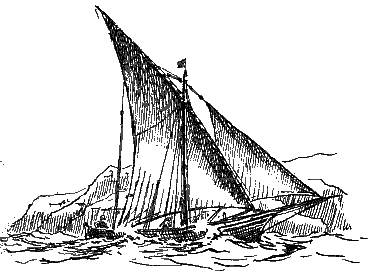 GIGLIO
TRAWLER, BEATING
GIGLIO
TRAWLER, BEATING
The yard, which is in two
or more parts according to size, spliced or fished
together, is hoisted by a halyard which passes in two
parts through a pair of masthead sheaves. A four-fold
block and a stout rectangular sheave built into the deck,
,just abaft the mast and standing some feet above the
deck, form the tackle for hoisting and lowering the sail.
A running parrel holds the yard into the mast. There is
generally a peak halyard to assist in taking a portion of
the weight off the yard, and in peaking it to the
required angle; but the set of sail is really controlled
by the heavy tack-purchase at the heel of the yard and by
the mainsheet. In running free a wonderful lifting-power
is given to the lateen by taking the sheet forward and
letting the tack-purchase run out; the yard then lies
across the ship, the triangle being upon its apex, the
peak dropping and the tack rising until the strain on the
sheet is about equalised. Where a jibheaded topsail is
set above the lateen-yard this cannot, of course, be done
to the same extent as in the smaller fishing-craft which
have but little gear aloft.
OLD GENOESE VINCO, 1845
When close-hauled the heel
of the yard sags out to windward in a way which is at
first somewhat embarrassing to the fore-and-aft sailor.
Its right position is formed, however, when the sheet is
into the required extent, and the strain along the foot
of the sail asserts itself. The tack tackles are used to
prevent the yard from swinging, which it does with
considerable violence in a seaway when the peak is being
subjected to a series of wild oscillations; one tackle is
brought aft and the other forward, or they are spread
athwartship as may be necessary as a result of the
position of the yard or the direction of its
movement.
TRAWLER, OFF ELBA
The sail is as a rule taken
in by being furled to the yard, two or more brails being
used in the first instance, to spill the wind, the canvas
being then furled and tied by a hand upon the yard. The
difficulty of the process naturally varies with the size
of the vessel, but even in a moderate sea, furling a
fifty-footer's lateen sail is no fun if you have had no
practice at it and are not possessed of prehensile
toes.
The virtue of the lateen,
which at first sight seems ill-suited a sail to such
squally coasts as those of the Mediterranean, is that it
can always be let go with a run in a heavy blow; and my
grandfather, who did many of his first surveys of that
sea in a lateen-rigged paranzello, used to speak with
emphasis of the handiness of the lateen in this respect.
At the same time, the yard is long and inconvenient on
deck, and it is better generally to keep it off the deck
if possible. In many of the Italian coasters regular
chocks are fitted to receive the long yard when lowered
in bad weather, and a small storm-sail ready bent upon
its yard is carried on the opposite side to the big sail
all ready to be hoisted when the other is secured in its
place.
NAPLES TRAWLER
The tricks which the
skilled lateen-sailor plays with his sail are endless,
and can be best seen among the trawlers off the Tuscan
coast, where, to suit the varying strength of the wind,
upper and lower spinnakers are set at one moment, and the
next the big mainsail is being skilfully emptied of half
its wind. When the trawls are hauled the yards are
allowed to swing out forward and are brought on deck. No
little experience is necessary to keep the sister boats
working together on a trawl-net at exactly similar speeds
as the changing puffs of wind come up astern, and there
is no rest with the sheets or with the small auxiliary
sails which are constantly being eased or tautened,
hoisted, spilled, or taken in.
SQUARE TOPSAIL LATEENER
1841
Only the trinchetto sails
of the Tagus muleta exceed the Tuscan fisherman's in
number and variety. But these boats are most beautiful
when bending close-hauled to a stiff breeze on the beat
home, when their weatherly qualities will delight any
sailor.
My father, who at one time
used one of the smaller Tuscan fishing-boats for a cruise
of some months' duration, used to speak with pride of the
power of his little craft to carry sail in strong winds;
but he was unfortunate in his crew, which consisted of
two men who, whenever it blew hard, first of all besought
him to run for a port, and when he refused used to get
out their rosaries and go upon their knees in the
lee-scuppers, where they remained praying and crying
until driven out of their retreat by an opportune
green-sea. But these were longshoremen, very different
from the generality of Italian fishermen, who are
probably the finest mast and sail men of the
Mediterranean at the present day, and whose one-masted
luggers from the Adriatic coast may be seen as far east
as the shores of Egypt.
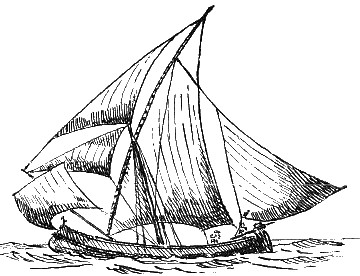 MOLETA
SAILS:
MOLETA
SAILS:
TAGUS, 1861
(FROM A SKETCH BY PROF. STOMY-MASEKELYNE)
From the records of the
Mediterranean during the beginning of the last century,
when, for the first time since the Crusades, it began
again to be a sea known to British sailors, it is evident
that the old three settee or felucca rig, the rig par
excellence of that sea was then far commoner in
comparison to others than is now the case.
SPANISH FELUCCA
The reason is not far to
seek. At that time the old methods of warfare were still
in vogue, and the three-masted lateen rig was well
adapted to long vessels of easy lines and low freeboard
of the galley type, which could be propelled at
considerable speeds in calm weather by a large crew of
rowers.
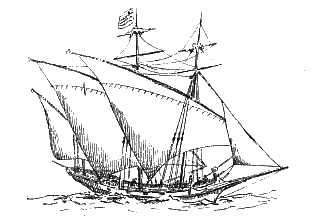 GREEK
FELUCCA PRIVATEER
GREEK
FELUCCA PRIVATEER
(FROM AN OLD PRINT, 1819)
For warlike purposes they
were used by the old Venetian and Genoese sailors of
earlier centuries, by the Moors on the Barbary coast, and
by the Greeks during the war of 1819, as well as by all
the great sea-fighting nations for their small craft
during the Napoleonic wars.
For large cargo carriers
and for warfare, steam has taken the place of the old
long sweeps, and the sail remains for the small coaster
and the fisherman where economy in crew is necessary, and
seagoing and carrying capacity are required as far as
they can be made compatible with restricted
size.
OLD BRIGANTINE - TORRE DI RIO,
1841
(FROM A SKETCH BY SIR W. WARRINGTON SMYTH)
For large-sized coasters,
therefore, the ordinary fore-and-aft or topsail schooner
and the ketch rigs are often seen on the coasts of Italy.
In the Adriatic especially the two-masted lugger is a
very frequently found. As late as the forties and fifties
examples of fair sized three-master lateens were still
common-in the beautiful bragagna of Dalmatia (a true
felucca, or rather settee in build and rig), in the
brigantine shown off Torre di Rio, and in the peculiarly
rigged velocera, which are both from sketches by my
father.
The last-named is a
development of what used on the Barbary coast to be known
as a xebec, which was a felucca with square yards on the
foremast.
OLD VELOCERA
(ELBA, 1841)
It was a rig which
gradually came into favour for larger vessels, the main
and mizen masts retaining the lateen yards. Not a few old
drawings show that the square topsail was very frequently
set during the last century over the lateen, as was done
over the gaff mainsail of our old smacks. This was not
only the case in the felucca-rigged vessels on fore and
main masts, but also smaller paranzellos and
others.
But as in northern
countries the fore-and-aft jib-headed topsail has
replaced the upper squaresail, so it has happened in the
Mediterranean, and the jib-header is seen even over the
lateen yard.
The three-masted, or settee
rig, without topmast, is still retained in parts of the
Mediterranean: one may instance the big coal-carrying
gaiassas of lower Egypt, and some of the fruit-carrying
and other long narrow-built boats in the neighbourhood of
Naples.
NEAPOLITAN FRUIT-BOAT
The mizen is undoubtedly
less common present day with the lateen-sail than it was
during the first half of the last century. At Genoa,
Leghorn, or Naples, the rig depicted in the Genoese bovo,
and that of the paranzello, are seldom seen, the one-mast
rig being the commoner. In some cases a fore-and-aft
mizen instead of a lateen may also be met with. It is not
easy to account for the lack of popularity of the mizen,
as the lateen mizen is easily handled in a wide- sterned
boat, and would be very serviceable in hard
weather.
For sharp-sterned boats,
however, such as the majority of the present small
traders of the western basin and the Adriatic are, the
mizen has its inconvenience if carried, as must be the
case with the lateen mainsail, right aft on the
taffrail.
FLYING TOPSAIL, SPANISH
FELUCCA
It will be noticed that the
lateen-sail of the Western Mediterranean differs
considerably in shape from that of the Indian Ocean and
Red Sea. It is only in the smallest boats that the
forward angle is cut off so as to make a piece of
square-cut luff. The he Arab lateen is almost invariably
so cut, and the sail is in truth a four-sided one. Its
disadvantage when so cut is apparent on a wind, when a
straight luff is more difficult to maintain, and the heel
of the yard is inclined to take charge in a seaway
because less controlled than it is by the Mediterranean
tack tackles. It appears to be tradition that the old
settees, small single-decked vessels of the felucca rig
but without topmast, generally carried sails of the
quadrilateral Arab pattern.
But the sail of the big
lateener of the western basin is usually more nearly an
equilateral triangle than that of the dhow, and it is
more sober in the amount of peak given to it. The lateen,
which is more exuberant in its peak, is of course that of
the inland gaiassa of lower Egypt.
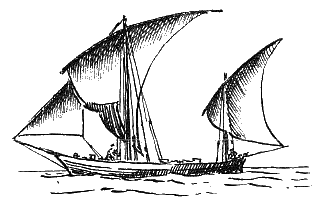 SCANDALIZED
SCANDALIZED
The western lateen always
remains on one side of the mast, and is never shifted for
a fresh tack. Its shape enables it to stand inside the
rigging of the mast, and not outside at the extreme
masthead as is necessary in the case of the Arab gaiassa,
as a result of the cut of the sail and its high peak. The
western lateen is thus far more snug to the mast, and
more easily lowered on deck, and is certainly a more
seamanlike and weatherly sail, while it is always made of
stout material cut and roped after the European
style.
A peculiar form of
fore-and-aft mainsail, reminding one of the 'curtain'
spritsail of Smyrna and Turkey, is that on the mainmast
of the velocera, which is still frequently met with in a
number of coasters in the Gulf of Genoa and the
Tyrrhenian Sea.
COASTER
(GULF OF GENOA)
The gaff is kept standing,
and is a very long spar hung from one-third to one-half
of the mast's length below the heel of the topmast; the
mainsail is hauled out along it, when set, and travels on
rings to the peak halyard slings. The peak is controlled
by vangs going to each quarter, and no boom is
used.
In conjunction with this
low-cut mainsail is a huge jib-headed topsail which
hoists on mast rings up the topmast, but is also laced
along the portion of the lower mast which intervenes
between the gaff and the heel of the topmast. When this
topsail is taken in, the mainsail left standing is about
equivalent to an ordinary sail with three reefs down, and
is certainly snug enough for most purposes. This
convenience is gained at the expense of a plan of
sail-spread which is far less efficient in ordinary
weather than that of the ordinary long-hoist fore-and-aft
sail and topsail.
BOVO
(GENOA)
With this sail the mast is
always given considerable rake aft, and while the lower
mast is long, the top and the topmast are both rather
short. The whole has rather a topple-over-stern air which
does not impress the stranger.
Though seldom met with in
three-masters at the present day, this arrangement is
generally seen in conjunction with the very old style of
foremast, placed right in the eyes of the ship and raking
over the bows, upon which the old galleys and feluccas
used to set the fore lateen. While the position of the
mast, the old trinchetto, has been retained, the heavy
lateen yard has been in these vessels taken off and a
large main staysail, set along a stay from the maintop,
is substituted.
THREE-MAST LATEEN
(NAPLES)
The first record which I
have been able to find of the use of this peculiar form
of staysail is in a sketch made by my father in 1841, in
the neighbourhood of Elba. In this case it is shown
fitted to an ordinary felucca-rigged boat, the staysail
taking the place of the fore lateen, it having been
apparently introduced as a storm-sail, when the fore yard
was lowered on deck in order to reduce weight of top
hamper.
The bowsprit, taking the
place of the old overhanging bow, to which the tack of
the lateen worked, remains in the modern rig in order to
carry a jib necessary to give the required head-sail in
ordinary weather.
The staysail is of the
four-sided type now in common use in square-rigged ships,
and is fitted on the foremast with mast-rings. It is a
handy sail with good lifting power, easily set and
stowed; its centre of effort is low, and it involves no
weight of spars aloft. But it is not remarkable for
beauty, nor for flatness of set when close hauled, the
upper fore angle being difficult to fill effectively on
that point of sailing.
Lying in harbour, these
vessels at first appear to have a set of very solid
jib-booms all 'on end,' but a closer inspection shows
that what appears to be a jib-boom is in reality the
old-fashioned foremast of history still
surviving.
This peculiar rig is
largely an outcome of the meteorological conditions
prevailing in the Gulf of Lyons and Tyrrhenian Seas,
which alternate between calm bonaccia weather, occasional
raggiature or land squalls, and the fierce, cold mistral
from the north; or again the labeseltades, south-westerly
gales of great violence, which blow home with a big sea
of short range and very destructive power.
The Adriatic
The Adriatic provides a new
rig to the sailor, for here is the powerful and
flat-setting boomed Italian lugsail, which is seen alike
in the trabacola or coasting trader, and in the
gorgeous-sailed bragozzi which is familiar to all lovers
of Venice and its colouring.
The weather in this sea is
notoriously unstable, and the harbourless condition of
the greater part of the Italian coast has rendered it
absolutely necessary to use a powerful rig capable of
working out to windward off a lee shore. Both with the
siffante or south-wester, and with the bora, the heavy,
westerly blast which has dismasted so many good ships,
sudden shifts of wind take place, followed by squalls of
such violence and fierceness that a snug sail-plan and a
powerful build of hull are alike essential.
TRABACOLA
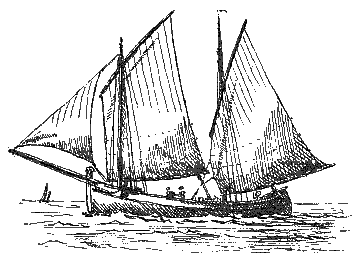 The
burst of a siffante on this coast is a thing not to be
forgotten. It is a hot morning, and the sun flashes off
the windows of the distant city, which bears a little
south of west. A long swell comes up from southward,
where a bank of threatening cloud lies, the upper edges
lit up like the summits of great snowpeaks. We lie up
close-hauled on the port tack to a light air from
south-west. The aneroid has fallen the part of a tenth
since our morning dish of maccaroni, which, by reason of
the swell and the hot sun, was perhaps not greatly
appreciated. It is consequently with much impatience that
we feel the roll, and long for wind, and eye the
threatening horizon. A dull film of cirrus brings a haze
over the sky above us, and the whole world seems to
silently threaten us with some terrific peril. Not long
after, the wind suddenly comes among a few spasmodic
white caps on the sea, sighs through our rigging, and is
gone again.
The
burst of a siffante on this coast is a thing not to be
forgotten. It is a hot morning, and the sun flashes off
the windows of the distant city, which bears a little
south of west. A long swell comes up from southward,
where a bank of threatening cloud lies, the upper edges
lit up like the summits of great snowpeaks. We lie up
close-hauled on the port tack to a light air from
south-west. The aneroid has fallen the part of a tenth
since our morning dish of maccaroni, which, by reason of
the swell and the hot sun, was perhaps not greatly
appreciated. It is consequently with much impatience that
we feel the roll, and long for wind, and eye the
threatening horizon. A dull film of cirrus brings a haze
over the sky above us, and the whole world seems to
silently threaten us with some terrific peril. Not long
after, the wind suddenly comes among a few spasmodic
white caps on the sea, sighs through our rigging, and is
gone again.
ANCONA FISHING-BOAT
Our close-reefed lugsail
bangs about over our heads, and strains every rope and
strand aloft. Then it comes, first a puff abeam, then one
nearly right ahead, and steady and stiffening minute by
minute. Night seems to settle down and cover us up. The
great strong bow breasts through the short breaking seas,
but the force of the wind presses her down until all our
lee side is awash, and the mast is at such an angle that
the foot of the sail is becalmed by our weather gunwale.
We are making terrific speed, but taking in water
everywhere. In the midst of this, and when we are
beginning devoutly to wish we had a less heavy boom and
roll of reefs to our sail, the mole of the harbour
appears soused in heavy sprays under our lee. Gently and
cautiously the sheet is slacked away by the strong-handed
crew.
AT ANCONA
The few minutes' run is
desperately exciting, because we are sailing by the lee,
and a gybe is imminent. A steep, fierce sea, showing its
angry white teeth, seems to spring down upon the
starboard quarter, the main-sheet suddenly falls in folds
into the water, and with a bang like a gun's the sail
sweeps across above our heads. The sheet and tack part
simultaneously, and the sail lies in a bag, pinned by the
gale in the rigging. However, it is a few moments more
into the lee of the mole, where with a short sweep we
round into the wind's eye. For a few minutes the sail has
charge aloft, but as every thing is slacked up, it is got
in without having broken any arms or legs, as it seemed
determined to do. Before night the sun is shining along
the low, cloudy sky, and the wind is hard, but
moderating.
ITALIAN FISHING-LUGGER
(PORT SAID)
To tell the truth, we felt
mighty glad we were so near the land, for, while it
lasted, there was a fierceness in it, a driving, hitting
power which seemed uncanny, and which left us feeling
surprised, bruised, and mystified, especially those of us
who were new to Eastern seas. The paralysing power of a
strong wind, which grips and holds down the limbs, and
overpowers the brain, and the stinging, vicious onslaught
of the hard, salt spray ceaselessly slapping the eyes and
face, if continued for many hours, are able to conquer
the stoutest will, and are the direct cause of many a sea
tragedy. It is at such a time that one feels their
pitiless strength, and realises why so often shipwrecked
crews are unable to do anything to save
themselves.
The typical Italian lugsail
seen in the Adriatic, and from thence carried to the far
corners of the Mediterranean by its enterprising seamen,
is what we term a balance-lug -- a Chinese lug without
the battens, laced to boom as well as yard, and when
hoisted set up by the tack purchase.
SHIP'S BOAT WITH ITALIAN
LUGS
To prevent a 'back sail'
against the mast, and to ensure flatness of set, the
Adriatic or Italian sail has its tack purchase brought to
the deck at some distance away from the mast.
The bragozzi, stern on, and
the topo, or mouse, of Venice show this peculiarity. If
the sail is hoisted on the starboard side of the mast,
the tack purchase comes to a point about midway between
the line of the mast and the starboard gunwale. I am not
aware that this method of setting down the tack of the
lugsail is adopted anywhere else.
Of the Adriatic sailing
craft, the best known, because the most seaworthy, and
the one which carries the largest proportion of the coast
trade, is the two-masted lugsail trabacola.
The high bow, the round
stern, and the deep rudder hung on the stern-post outside
the vessel, are characteristics of this as of most of the
purely Mediterranean types of craft.
ITALIAN COAST LUGGER
The mainsail is set on a
mast stepped well inboard, and although generally smaller
in actual area than the foresail, it has the power of a
mainsail rather than of a mizen. It is of standing-lug
cut, and the luff is generally set taut by
bowlines.
The fore-lug is more of the
character of a balance lug proper, for it has a
considerable length of boom and area of sail forward of
the mast. The tack-rope is often so slackened up as to
allow a large portion of the sail to swing out forward,
giving the sail an odd appearance, suggesting that it
requires setting up; but on certain angles of wind it is
considered to draw better when thus set. The pilot-boats
of Alexandria are rigged in this fashion, and it is an
excellent rig for open or ships' boats which require
short spars and modest sail-spread. But they would be the
better in general for a light bowsprit and jib on most
points of sailing.
The bowsprit of the
trabacola, like so many of those in the Mediterranean, is
topped up at a high angle, and carries one or more jibs.
These boats are of beautiful lines and great power, and
constitute one of the finest forms of sea-going luggers
in the world.
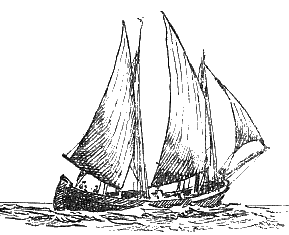 ADRIATIC
LUGGER
ADRIATIC
LUGGER
Another form of lugger very
similar to this occurs in the big two-masted traders of
the Spanish coast, which appears to be an outcome of the
same ideas, and like the two-masted lateen felucca, also
in use there, it shows evident connection with the
general mast and sail plan adopted by the French and
other Latins.
They both carry the
somewhat long-yarded but squareheaded lugsail which the
southern races often substitute for the lateen. Both show
the same tendency to obtain the balance of sail by
placing the foremast right forward, and setting a lugsail
upon it, sometimes a little larger even than the
mainsail, thus avoiding the need of the stay foresail so
generally adopted by the northern races, who place the
forward mast well back from the stem-head.
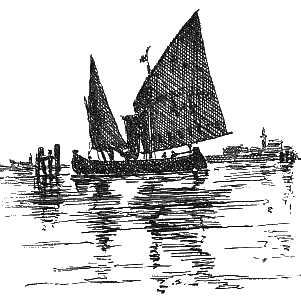
IN THE LAGOON
The bowsprit and jib are
modern adjuncts both with the Norse and the Latin races,
and only came into general use during the nineteenth
century. The jib has proved itself useful a sail that it
is now almost universal with lateen and lug-rigged
vessels alike.
The Venetian boats are
remarkable for the very slight draught forward, and
consequently they carry centre of effort of their sail
area very far aft. Many of the small fishing-craft, like
the topo, may be seen sailing with what looks like a
large mizen, only stepped well inboard. At first one
feels a keen desire to present their owners with a
foremast and headsail after the usual proportions. But
further consideration soon shows that the sail is
correctly placed relatively to the centre of lateral
resistance, which is much further aft than in most
boats.
BRAGOZZI
The insignificance of the
foremast and foresail of the bragozzi, and the importance
of the large, gaily coloured mainsail, are due to this
cause. The trabacola and other deep-water craft have
necessarily far more underwater body forward, and thus
can carry a sail-plan more suited to seagoing purposes.
But the light craft of the Lagoon of Venice are of the
flat-bottomed, mud-larking type, capable navigating
shoal-waters with a minimum of draught a maximum of
carrying power. Wherever their owner can wade they must
carry him and his wares. Of his deep channels are far
between. And they are q??? turn a
r, light to move to with the stroke of long oar an air of
wind or by a pair of arms, steady to carry 11 weight of
goods, and not to flinch at a squall of wind and at the
short ripple which soon gets UP in the wind Lagoon
waters.
SAIL PATTERNS, VENICE
What beautiful memories
that little topo under sail brings back! The wide grey
waters under a grey rimmed by low grey islands and tall
grey towers; the sparkling blue of a sunny day, with the
far city, long unchallenged mistress of the sea-world, in
all colouring, and the snow-white, distant range, on the
sky-line; the lapping of the tide along the piles, the
cheery voice of my friend Antonio instructing ??? in
short cuts across the flats, the character of his
friends, or stories of the days of the old Republic's
greatness.
BRAGOZZI
The big single-mast lugger
of Ancona and the south is in build a smaller trabacola
fitted with one mast in place of two.
TOPO (VENICE) 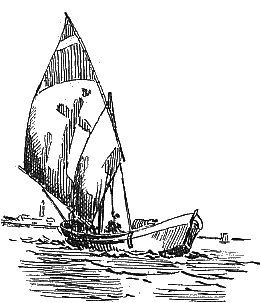
Her big mainsail is of the
same pattern as that of her big sister, and her
bowsprit stands up at the same
truculent angle. Capable, wandering sea-boats, they are
to be seen heading up to a gregale off Malta, or away
down east running with dry decks before the long roll of
a Levanter.
TOPO (MOUSE) 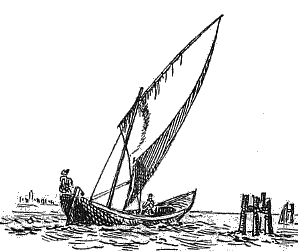
The Eastern
Basin
The Italian form of lugsail
takes us among the modern Greek fishermen, who use it in
many of their sponge-boats and other fishing-craft, and
in their small traders of the Archipelago. But the
Greeks, although they built and fitted out quite a fleet
of felucca-rigged privateers in the early wars of the
nineteenth century, are not really sailors at heart.
GREEK LUGGER
Our own seamen in times
past had a very poor opinion of the seamanship of the
pukka Greek, and a naval officer who spent three years of
one commission in and about the Aegean, declared that he
could never get any information out of a Greek pilot
except long lists of omens foreboding bad weather, or of
ports to run to when the wind should freshen
up.
It must in justice be
admitted that navigation under sail in small craft has
its drawbacks in a sea where the wind, even in weather of
an apparently settled character, is liable to such sudden
shifts as is here the case.
BRINDISI
LUGSAIL
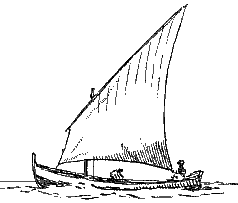
The sheltered anchorage of
one hour is a dead lee-shore the next; the greater the
apparent protection when the anchor is dropped close in,
the more imminent the danger when the wind is blowing a
sudden gale right on the rocks.
GREEK
COASTER
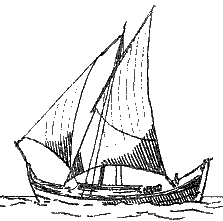
A southerly wind and fine
weather may suddenly shift to due north with a heavy
squall and confused sea, while six miles to the eastward
a distant sail is seen with a fresh easterly wind. *1*
Such incidents, frequent as they are in an archipelago of
deep soundings and few real harbours where ground-tackle
is of service, have had the effect of almost driving the
not too daring Greek of the mainland off the
sea.
*1* Admiral W. Smyth's Mediterranean.
A large part of the trade
and fishing of the Aegean and Levant is carried on by
Turks, who, although not perhaps such skilled sailors as
the Arabs and the Moors have been, have yet all the
courage and pertinacity of their co-religionists at
sea.
TURKISH COASTER
A favourite rig, to be seen
alike among the islands of the Archipelago and in the
Dardanelles, is the single-masted spritsail vessel
carrying a square topsail, fore Staysail, and one or more
jibs. The mainsail is hauled out along an almost
horizontal line to the spreet end.
There is no boom, and the
spreet is controlled by vangs. The sail can be hauled
into the mast with great rapidity and ease, and it is a
quick and simple method of brailing and reefing which
commends itself to the cautious Eastern sailor. As a rule
it is badly set, being cut to bag in a manner less
artistic than serviceable, this mode of cut, dear to the
Eastern heart, being more conducive to speed when handled
by those who understand it than we generally imagine,
especially in heavy-laden craft.
SMYRNA COASTER
The Turkish boat is built
long of bow, low in waist, round of bilge, and high of
stern. The latter is rounded and generally has the rudder
slung outside on the curved stern-post. The low waist is
often protected by a duck or canvas strake, which is
easily removed in light weather for pulling, as in many
of the Greek boats of the Archipelago.
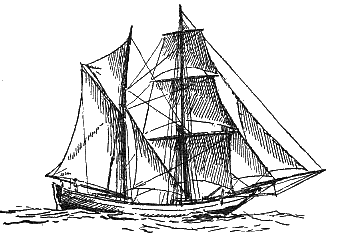 LEVANTINE
BRIGANTINE-
LEVANTINE
BRIGANTINE-
POLACRE RIGGED
Simple sprit or low-yarded
lateen boats are used for fishing and cargo-carrying in
the Bosphorus. They have the same general features of
build, and a fore staysail or jib, and are known as
mahona. But the most typical craft
of Turkish waters, next to the caique -- the long-bowed,
wide-sterned rowing boat of the Bosphorus -- is the
polacre-rigged trader. This class of vessel was very
common at the beginning of the nineteenth century, and
although still met with on other coasts, as in the Tuscan
bombarda, not quite extinct, it is most popular with
Eastern Mediterranean seamen.
IN THE BOSPHORUS
As a rule it is what we
should term a pole-masted brigantine, but the name can,
and used to, be applied to any square-rigged vessel
having pole-masts.
FISHING AND CARGO BOATS
As is implied by this
description, the yards are lowered right down to just
above the foreyard for furling; there are no foot-ropes,
the crew standing on the yard below from which they can
just reach to furl each sail above. There are no tops,
and the mast has a peculiar tapering appearance not
unpleasing to the eye.
The mainsail is either a
balance-lug or of the fore-and-aft pattern, with very
long boom, and the mainmast, in the latter case, is often
in two parts, and is fitted with main and main-topmast
staysail and jib-headed gaff topsail. It often acquires a
tipsy-looking rake forward, while the foremast adopts a
somewhat similar drunken rake aft. The crews are inclined
to bestow more pains upon the cleanliness of the sails
and gear aloft than upon that of their own persons or of
their cabins. Yet some of these little brigantines are
perfect pictures, and are greatly cared for by their
owners.
IN ALEXANDRIA HARBOUR
I shall always remember the
little vessel which we saw one night as we steamed
eastward in a big mail boat, a few hours before entering
the Canal. The sun was low astern of us, when, 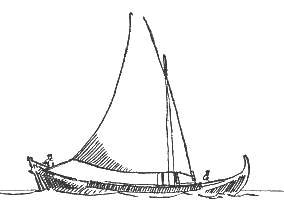 crossing
our bow closehauled to a brisk westerly breeze, a
white-sailed polacre brigantine of not more than 150 tons
passed us. She was deep-laden, and her long bow had the
look of a dolphin as she rose through the swell. She was
sailing very fast, with every sail drawing full and
bathed in the sun's rays, and she threw the spray off to
windward in showers into the deep blue of the sea. The
whole ship's company watched her in admiration until she
was far away on our quarter -- a beautiful vision come
and gone of the lands and seas we were leaving behind us,
some of us, alas! for ever.
crossing
our bow closehauled to a brisk westerly breeze, a
white-sailed polacre brigantine of not more than 150 tons
passed us. She was deep-laden, and her long bow had the
look of a dolphin as she rose through the swell. She was
sailing very fast, with every sail drawing full and
bathed in the sun's rays, and she threw the spray off to
windward in showers into the deep blue of the sea. The
whole ship's company watched her in admiration until she
was far away on our quarter -- a beautiful vision come
and gone of the lands and seas we were leaving behind us,
some of us, alas! for ever.
|
|
|
|
ABOVE: BEANPOD
(TAGUS, 1861)
|
|
